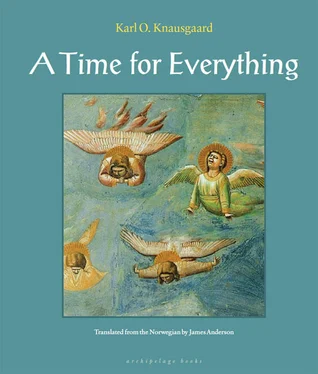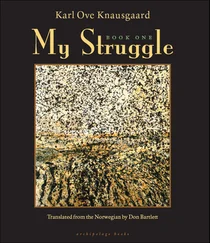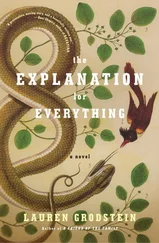
IT WAS the last time Ezekiel was to see the cherubim. The Lord’s voice came to him regularly until the day he died, right to the end it was giving him new tasks, but the Lord himself, that half-metallic, flame-enveloped figure he’d seen by the River Kebar and at the temple in Jerusalem, was, just like the cherubim, never to be revealed again.
This lends the two revelations an extraordinary weight.
But how is one to understand them? What did they mean?
Why was the first one preceded by the cherubim’s slow, studied materialization? The description of them fills more than two-thirds of Ezekiel’s story, and can hardly be interpreted as anything other than insistence.
But on what? What do the cherubim represent here?
And why are the cherubim so passive in the second revelation? They simply stand there, in the midst of the inferno, completely motionless, like a sort of eye in God’s storm.
The contrast between the cherubim’s calm and the Lord’s fury is striking. It’s there right from the first moment: hardly has the angels’ slow dance in the sky finished before God begins his accusations against the Israelites. And his frenzy doesn’t abate after the first flush of anger, on the contrary, it increases in vehemence, until it reaches its absolute apogee in Jerusalem’s temple.
The Lord had been angry before, even in the Garden of Eden he’d displayed that side of his character. But in the Garden of Eden it had softened almost at once; shortly after his outburst he had actually sat down and made clothes for the two fallen human beings, so that they would get a good start out in the world.
But this wrath doesn’t die down, rather it increases. It almost looks as if he can’t find any way out of it. But this isn’t why the cherubim’s presence is required. What is new about this anger is that the Lord wants to convey it. The emphasis is therefore taken away from the sins of man (which are constant), and the Lord’s punishment of them, to his feelings about them. It is the anger in itself that is important here, not what has caused it.
The change itself is indisputable. The question is why it came about. What could the Lord gain by allowing mankind to share in his feelings concerning them? Why did he make Ezekiel eat the scroll of lamentations?
Previously, and largely by means of the frighteningly detailed commandments he handed down to Moses, the Lord had told mankind what was right and wrong in the hope that this would be enough to make human beings live the way they ought to. But it wasn’t. Their failings were constant, his commandments were ignored, man’s life continued in sin. If only they knew what sorrow they occasioned in his heart, God must have thought, they might possibly change. If only they could understand the pain it causes me to look on them!
But if mankind began to see itself through God’s eyes, he was getting dangerously close to them. That is why the cherubim have such a prominent place in these two revelations. Just as when they appeared in the Garden of Eden, the cherubim here are also, at one and the same time, the guardians and the representatives of the outer limits of the divine. But this time their presence is perhaps even more necessary, because the Lord himself is outside the boundary they mark. The cherubim’s presence represents the divine’s original relationship to mankind, indifferent to us and our works as they are , writes Bellori. The Lord’s frenzy represents an aberration, unthinkable a few centuries earlier but extended and taken to its absolute limit a few centuries later, when God let not only his words be incarnated in a man, but his entire being .

THE FIRST church fathers expended much energy arguing that Christ’s resurrection was of a physical nature, not a spiritual one — the latter was a Gnostic view to which the church took strong exception. In his magnum opus The City of God , for example, Saint Augustine dedicates the whole of the twenty-second volume to this question. Christ was raised to heaven in the flesh in which he existed, Augustine writes, and the same will happen to everyone on the Day of Judgment. He discusses the various problems raised by such a view — would those whose faces or bodies were damaged by death be resurrected undamaged and whole? Would women arise in their own sex, and continue a member of it? Would even unborn babies be resurrected? If so, in what form? As fetuses, or in the form they would have had as adults? How long would the hair and nails of the resurrected be (Christ said, But not a hair of your head shall be lost )? And when he holds out the unnatural aspect of the physical resurrection of the dead, he doesn’t do it by referring to God’s omnipotence generally, but clings to the concrete perspective, and tells of the innumerable corporeal wonders he, or other people he trusts, has witnessed. On the estate of Audurus a small boy fell under the wheel of a skidding oxcart, his body contorted and he died immediately, but when his mother placed him by an altar dedicated to Saint Stephen the martyr, he came back to life and all his injuries disappeared. Another boy was possessed by an evil spirit one lunchtime while watering his horse in a deep pool in the river on the estate of Victoriana, and he lay as if dead when they carried him to a chapel in the vicinity and sang hymns for him. As the demon clung fast to the altar, it wailed aloud and threatened to cut off the boy’s limbs, until making a huge uproar it finally left him. It had left one of the boy’s eyes hanging down on a thin thread on his cheek like a root, with the pupil turned white instead of black. One of the people present replaced the hanging eye as best he could, writes Augustine, and a week later it was perfectly healthy again. At Kartago, a woman by the name of Innocentia discovered she had a lump in her breast; the doctors told her it was incurable, but in a dream she was told to make the sign of the cross on the first newly baptized woman she met, and when she did so, the lump disappeared. Because of a curse from their mother, ten children from Caesarea had been punished by heaven with severe trembling. They couldn’t stand the looks their repellent condition elicited from their fellow citizens, and they began to wander across the Roman Empire. Two of them, a brother and a sister, came one day to Hippo, where Augustine was bishop. Everyone noticed them because of their grotesque shaking limbs. It was Easter, and as the boy touched the reliquary in Saint Stephen’s chapel during his prayers, he suddenly fell down and lay on the ground as if sleeping. He no longer shook, as he normally did even when asleep, and when he came around, he was still free from the shaking. People praised God and came pouring in to Augustine to tell of the miracle, who for his part read from the Bible, and then enjoined them not to listen to God’s fine words, but rather to see him in his divine works. The next day he allowed the brother and sister to stand on the pulpit steps from which he told their story. The whole town was present, and saw them standing there, she with her trembling hands, feet, and head, he completely still. When a moment later she knelt before the reliquary, she also fell to the ground, as if asleep, and rose up cured like her brother. In their rejoicing hearts there was nothing but the belief in Christ for which Stephen had shed his blood! writes Augustine.
Blood, dangling eyes with white pupils, tumors and shaking limbs, stillborn fetuses, hair and nails, maltreated bodies, and the physical resurrection of the flesh on the last day is how the divine manifests itself in Augustine. However, just like all the other great church fathers, he was convinced that angels were pure spiritual beings.
Читать дальше













